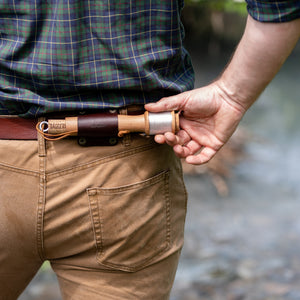How To Make The Perfect Survival Fishing Kit
Fishing is an excellent skill that humans have been perfecting since the dawn of time. It continues to be a craft worth learning, especially for those interested in wilderness survival.
If you ever find yourself in a situation where you need to fish in order to survive, whether you’re faced with an unexpected emergency or a long-term economical scenario, it’s imperative that you have the right tools at your disposal.
Never venture into the wilderness without these essentials in your fishing kit:
-
Over-the-shoulder Fishing Bag or Backpack
Your survival kit does not exist without a device to store everything in. You will obviously need a suitable bag to carry all of your gear, including your tackle box and nets.Some survivalists recommend storing this bag in your car, or anywhere that it will be easily accessible.
-
Tackle Box
It is not practical to loosely store small, sharp items (like hooks) in your backpack. You will need a small tackle box to properly store hooks, fishing line, lures, etc.
-
Fishing line
Your survival fishing kit should contain at least 50 feet of monofilament fishing line tested to 10 to 20 pounds strength.
Wrap the line around an object that will easily fit inside your kit yet is large enough to keep the line from becoming kinked and tangled. A water bottle may do the trick.
-
Hooks
Pack hooks of varying sizes in your survival fishing kit.
Having small hooks handy could potentially increase your chances of catching a meal.
In an ideal situation, you will be familiar with the body of water you’ll be fishing and know exactly what species of fish call it home. This would make picking the hooks best suited for catching those fish much easier.
Unfortunately, many survival situations do not end up working out to be ideal. As a general rule of thumb, opt for small hooks-- especially if you are unsure of the species of fish swimming in the body of water you are fishing. Small fish are not able to bite large hooks, but large fish can bite small hooks.
-
Bobbers
Bobbers aren’t necessarily essential, but they do help anglers to keep an eye on their line. They can also be useful in determining whether or not fish are biting.
If you find yourself in a situation without any bobbers, don’t worry. In a pinch, you can use a piece of Styrofoam or even cork as a bobber. Anything that floats will work fine as a substitute.
-
Sinkers/ Weights
Sinkers not only aid in casting the line, they also ensure that bait finds its way into deep enough waters to entice a worthy catch. Big fish don’t usually lurk in shallow waters.
Pack around 12 sinkers in your survival fishing kit. These items tend to get lost easily, so you will want to have an ample supply of sinkers.
-
Fishing Lures
A lure encourages fish to bite, which means that it will help you to make a catch quicker than dropping in an empty hook and just hoping for the best.
Make sure to include lures that can be used for multiple fish species in your survival fishing kit.
-
Bait
It’s true that you can scrounge up some worms and other insects to use as bait, but having a supply readily available can be a great time saver. In any survival situation, time is of the essence.
Some survivalists recommend keeping a jar of salmon eggs on hand to use as bait.
-
Reel
In desperate situations, you can construct a fishing pole out of a stick. But investing in a light-weight, high quality travel rod is a much better option.
Opt for any of these great Daggerfish rods. These products are easy to use and perfectly designed for anglers with any level of experience to fish in a backcountry environment.
-
Bushcraft Knife
A high quality bushcraft knife can prove to be one of the most useful tools you can carry with you into the wilderness. A bushcraft knife can be used to carry out a variety of survival tasks, from helping make camp to cleaning and preparing fish for a meal.
Opt for a stainless steel knife for your survival fishing kit. Stainless steel does not require as much care as other materials, like carbon steel. Because stainless steel is resistant to corrosion, it is typically a more sanitary option to use on preparing food.
-
Gill net
This wall of netting, typically made of monofilament or multifilament nylon, is a great way to catch fish. These long, rectangular nets are incredibly efficient. The more a fish struggles to free itself from a gill net, the more entangled in the net it will become. However, many states have banned the use of gill nets. In a survival situation, you may not care what the law allows, but make sure these nets are not illegal in your area before packing one in your survival fishing kit.
-
Hand net
Hand nets are also known as scoop nets or dip nets. These nets typically form a mesh basket held open by a hoop at the end of a handle. These tools are useful for scooping up fish that are near the surface of the water.
This list should cover everything you will need in your survival fishing kit. Always be prepared for anything and be sure to have everything you need prepared to stay ahead of the game.



















